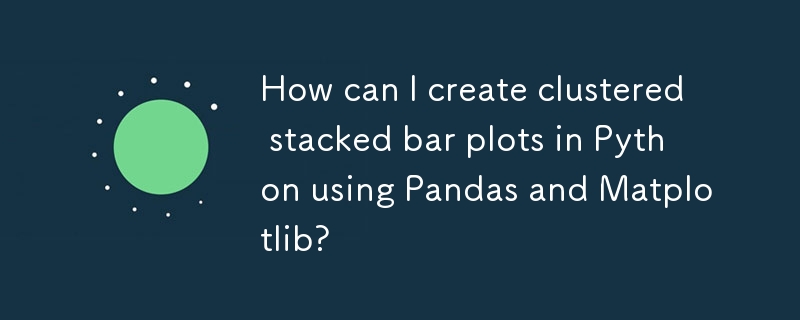

Pandas と Matplotlib を使用したクラスター化積み上げ棒グラフの作成
この記事では、Pandas を使用してクラスター化された積み上げ棒グラフを作成する方法を検討します。そしてMatplotlib。この手法を使用すると、同一の列とインデックスを持つ複数のデータセットを横に並べてバーを積み重ねて視覚化できます。
問題の理解
次の点を考慮してください。シナリオ: 3 つのデータフレームがあり、それぞれに同じインデックスを持つ列 "I" と "J" の値が含まれています。データフレームごとに積み上げ棒グラフを作成する必要がありますが、特定の方法で配置します。
解決策の実装
次のコード スニペットは、この問題に対する効率的な解決策を示しています。
<code class="python">import pandas as pd
import matplotlib.cm as cm
import numpy as np
import matplotlib.pyplot as plt
def plot_clustered_stacked(dfall, labels=None, title="multiple stacked bar plot", H="/", **kwargs):
"""Given a list of dataframes, with identical columns and index, create a clustered stacked bar plot.
labels is a list of the names of the dataframe, used for the legend
title is a string for the title of the plot
H is the hatch used for identification of the different dataframe"""
n_df = len(dfall)
n_col = len(dfall[0].columns)
n_ind = len(dfall[0].index)
axe = plt.subplot(111)
for df in dfall : # for each data frame
axe = df.plot(kind="bar",
linewidth=0,
stacked=True,
ax=axe,
legend=False,
grid=False,
**kwargs) # make bar plots
h,l = axe.get_legend_handles_labels() # get the handles we want to modify
for i in range(0, n_df * n_col, n_col): # len(h) = n_col * n_df
for j, pa in enumerate(h[i:i+n_col]):
for rect in pa.patches: # for each index
rect.set_x(rect.get_x() + 1 / float(n_df + 1) * i / float(n_col))
rect.set_hatch(H * int(i / n_col)) #edited part
rect.set_width(1 / float(n_df + 1))
axe.set_xticks((np.arange(0, 2 * n_ind, 2) + 1 / float(n_df + 1)) / 2.)
axe.set_xticklabels(df.index, rotation = 0)
axe.set_title(title)
# Add invisible data to add another legend
n=[]
for i in range(n_df):
n.append(axe.bar(0, 0, color="gray", hatch=H * i))
l1 = axe.legend(h[:n_col], l[:n_col], loc=[1.01, 0.5])
if labels is not None:
l2 = plt.legend(n, labels, loc=[1.01, 0.1])
axe.add_artist(l1)
return axe
# create fake dataframes
df1 = pd.DataFrame(np.random.rand(4, 5),
index=["A", "B", "C", "D"],
columns=["I", "J", "K", "L", "M"])
df2 = pd.DataFrame(np.random.rand(4, 5),
index=["A", "B", "C", "D"],
columns=["I", "J", "K", "L", "M"])
df3 = pd.DataFrame(np.random.rand(4, 5),
index=["A", "B", "C", "D"],
columns=["I", "J", "K", "L", "M"])
# Then, just call :
plot_clustered_stacked([df1, df2, df3],[“df1”, “df2”, “df3”])</code>使用Function
この関数を使用するには、リストを渡します最初の引数としてデータフレームの数を指定します。次の引数には、凡例のラベルのリストを指定できます。 title 引数はプロットのタイトルを指定します。最後に、H は各データフレームを区別するために使用されるハッチング パターンを表します。
出力
結果のプロットには、各データフレームのクラスター化された積み上げ棒が並べて表示されます。各インデックスのバーは互いに積み重ねられ、異なるハッチングが異なるデータフレームを示します。
追加機能
色のカスタマイズ:
cmap 引数を plot_clustered_stacked に渡すことで、バーの色をカスタマイズできます。 matplotlib カラーマップのインスタンスを取得する関数。以下に例を示します。
<code class="python">plot_clustered_stacked([df1, df2, df3], ["df1", "df2", "df3"], cmap=plt.cm.viridis)</code>
結論
このアプローチは、Pandas と Matplotlib を使用してクラスター化された積み上げ棒グラフを作成するためのシンプルで効果的な方法を提供します。これにより、複数のデータセットを並べて明確かつ有益な方法で視覚化できます。ハッチング パターンと色を調整することで、特定の要件に合わせてプロットをさらにカスタマイズできます。
以上がPandas と Matplotlib を使用して Python でクラスター化された積み上げ棒グラフを作成するにはどうすればよいですか?の詳細内容です。詳細については、PHP 中国語 Web サイトの他の関連記事を参照してください。